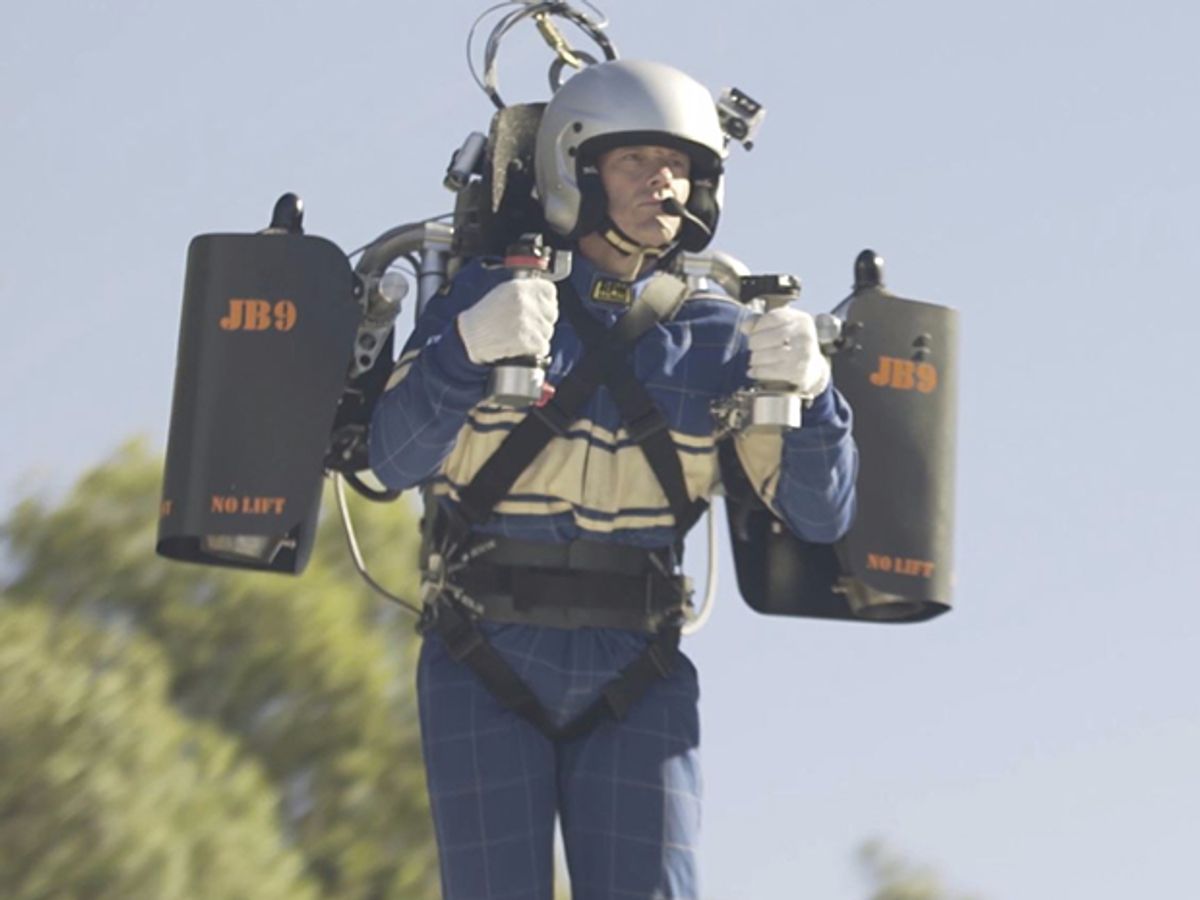The reality of personal jetpacks has been a disappointment. It's almost been more disappointing than if they'd been left to science fiction, because reality hasn’t come anywhere close to living up to what comes to mind when we imagine what a personal jetpack should be like.
One of these disappointments was the RocketBelt, which had the right form factor, but let you fly for only 30 seconds before running out of fuel. The RocketBelt's inventors have been working for the last 40 years (!) on something better, and they've finally managed to develop an honest-to-goodness backpack-sized jetpack. It runs on actual jets, it (probably) won't set you on fire, and the videos make it look exactly like what we've been fantasizing about.
First, a quick dismissal of recent things that have called themselves jetpacks. There are hydrogen-peroxide rocket belts, whose onboard fuel supplies don't offer enough flight time to be at all practical. There's the Martin jetpack, which is really a small vertical-takeoff-and-landing aircraft powered by ducted fans that you strap to your body. And there are jet wings (like these) that depend on lifting surfaces for flight.
A real jetpack needs to be small and light enough that you can put it on and walk around. It needs to be safe enough and reliable enough (in principle if not in practice) for regular use. And most importantly, it needs to be able to take off vertically, fly for a useful distance and time, and land vertically without turning its passenger into goo. Jetpack Aviation's JB-9 does all of these things.
The JB-9 runs on actual turbojet engines. Turbojets are the original jet engine, and were responsible for powering the Messerschmitt Me 262 as well as the Gloster Meteor. You don't see turbojets in aircraft anymore because they've been replaced by the much more fuel efficient turbofan. Turbojets do still offer very high power density and impressive power to weight ratios, which, for something like a jetpack, is exactly what you need. For example, a turbojet designed for model aircraft produces 230 newtons (52 pounds) of thrust from a 12.7-centimeter-diameter engine that weighs only 2.5 kilograms.

Jetpack Aviation's system uses a pair of small turbojets of the type shown here [photo,right], although they look significantly larger and more powerful, and we're guessing that they're custom made. We don't know how much thrust they produce, but we do know that the JB-9 as a whole sucks down just under 4 liters of fuel a minute. The engines are really the only complicated part of the JB-9. The big backpack part is the 38-liter fuel tank, and most of the controls are purely mechanical. Hand controls adjust engine thrust to control yaw; tilting the engines themselves alters pitch; and the pilot leans slightly in order to roll.
In terms of performance, the JB-9 will fly for at least 10 minutes before running out of fuel, with its specific endurance dependent on how much the pilot weighs. Top speed of the JB-9 is about 100 kilometers per hour, with a climb rate of between 150 and 300 meters per minute. Both the speed and climb rates will increase as fuel is burned off. Jetpack Aviation speculates that you'd have no trouble hitting 10,000 feet.
The JB-10 (which is already undergoing test flights) should be able to hit "well over" 200 km/h in horizontal flight, and future improvements will thankfully include a ballistic parachute and sensor-driven automatic stabilization to make the jetpack safer and easier to fly.

Sadly, Jetpack Aviation knows better than to sell you or me one of these things right away, and there's not even the slightest bit of talk related to price or availability. To be optimistic, though, this contraption seems like it’s not an absurdly complex or expensive piece of hardware to construct.
So let’s do a quick back-of-the-envelope guesstimation. Getting all the pieces to work together like they should certainly took a lot of time, testing, and experience on Jetpack Aviation’s part, and we're not trying to minimize that in the least. But, the most expensive parts seem like they have to be the engines.
That hobby engine we looked at—the one that produces 230 newtons of thrust—will run you only $4,300. This isn't to say that a jetpack will cost less than $10,000. Our guess is that a commercial version will cost something in the range of a luxury car or perhaps a light aircraft, as opposed to private jet. And this is fortunate, because IEEE Spectrum can afford only two private jets for its reporters, not three.
Evan Ackerman is a senior editor at IEEE Spectrum. Since 2007, he has written over 6,000 articles on robotics and technology. He has a degree in Martian geology and is excellent at playing bagpipes.



